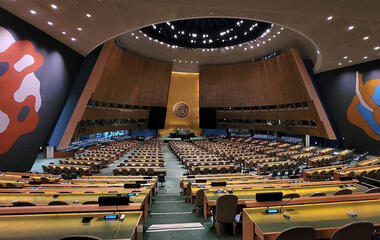The UN General Assembly adopted the Pact for the Future on Sunday night in New York, which offers a blueprint for bringing the increasingly divided world together to tackle global challenges spanning climate change, increasing inequality, poverty, hunger, a rising number of conflicts and the fast-growing influence of artificial intelligence.
Included in its annexes are a Global Digital Compact and a Future Generations Declaration.
The Global Digital Compact marks the first truly worldwide agreement on the international regulation of artificial intelligence (AI) and is founded on the idea that technology should benefit everyone, according to a UN statement.
The Future Generations Declaration commits to embed the needs and interests of future generations in policymaking.
The UN described the pact as a landmark declaration pledging concrete action towards a safe, more peaceful, sustainable world, a key recommitment to its efforts to get the world back on track to achieving the UN Sustainable Development Goals.
“We are here to bring multilateralism back from the brink,” said UN Secretary General Antonio Guterres, thanking world leaders for taking the first step to opening the door to a better future. “Now it is our common destiny to walk through it. That demands not just agreement, but action,” he noted.
Before the negotiations, the Education and Academia Stakeholders Group (EASG) had issued a statement criticising the failure to make education a key part of the agenda of the pact to be agreed by the UN Summit of the Future, as reported by University World News.
The final text slightly increases acknowledgement of education’s role compared to the original draft – with 20 references to education compared to just four in the original – but fails to mention the crucial role of education for sustainable development (ESD) in preparing young people to go out into the world and champion sustainable development and planetary health.
Neither does the pact explicitly acknowledge the critical role of universities in contributing to breakthroughs in science, technology and innovation or their vital work in social sciences, which is critical to changing human behaviour and solving local and global challenges.
The important role of international partnerships in higher education and research to address inequality and support capacity building is largely missing.
Jacob Blasius, co-chair of the Education and Academia Stakeholder Group (EASG) and executive director of the Global Student Forum, told University World News: “Mentions of education, especially higher education, are sparse and limited. Notably, Education for Sustainable Development is entirely absent from the pact.”
Charles Hopkins, UNESCO Chair in Reorienting Education Towards Sustainability, York University, Canada, told University World News that while he welcomes the pact and is pleased with the Declaration on Future Generations, and the Global Digital Compact, he was particularly disappointed that negotiators failed to heed the call from the Education and Academia Stakeholder Group to recognise the key role of Education for Sustainable Development or ESD in achieving the societal change needed to fulfil the SDGs.
“Despite ESD being recognised on four occasions, 2017, 2019, 2021 and 2023 on the floor of the UN General Assembly as the key enabler of all 17 SDGs, ESD was not mentioned in the pact,” he noted.
He said it was evident that the role of education as perceived by most country negotiators was the traditional one of providing basic education to enhance the country’s workforce potential.
“While this is important, it misses two key factors. The first missed opportunity is the use of education to build public understanding of sustainability issues and hence the chance to strengthen both political and consumer support for enlightened legislation and product.
“The second is the transforming capacity of ESD, including training to perform the SDG key enabler role,” he added.
Hopkins said there are several important messages for higher education leaders to take from the Summit of the Future.
“The first is that higher education is either not performing to its potential, giving it the necessary visibility, or it is contributing in a way that simply goes unnoticed.
“It may be both, but the bottom line is we must address both by enhancing our contribution to sustainability and enhancing recognition by governments of what we are doing,” he said.
Blasius noted that the pact does not mention universities directly, but in its annex, Global Digital Compact, research cooperation of universities in North-South, South-South, and triangular cooperation is called for.
He said the pact also calls for lifelong learning and the expansion of education opportunities, especially for vulnerable and marginalised populations. “This underscores the need for educational institutions to prioritise accessibility, diversity, and inclusion in their policies and outreach programmes,” he noted.
For students one the most significant outcomes of the pact is the recognition of youth as critical stakeholders in shaping a sustainable and equitable global future and he believes universities have a role to play in showcasing youth participation.
“The commitment to increase youth participation in national and international decision-making processes is a major step forward. By emphasising the inclusion of youth in governance, peacebuilding, and policy discussions, the pact calls for young people to have a meaningful voice in the decisions that impact their futures,” he said.
World at a ‘tipping point’
The version of the pact adopted by world leaders on behalf of the whole of humanity warns: “We are at a time of profound global transformation. We are confronted by rising catastrophic and existential risks, many caused by the choices we make.
“Fellow human beings are enduring terrible suffering. If we do not change course, we risk tipping into a future of persistent crisis and breakdown.”
But it stresses that this is a moment of hope and opportunity, a chance for renewal and progress grounded in humanity because “advances in knowledge, science, technology and innovation could deliver a breakthrough to a better and more sustainable future for all”.
“Through the actions we take today, we resolve to set ourselves on that path, striving for a world that is safe, peaceful, just, equal, inclusive, sustainable and prosperous, a world in which well-being, security and dignity and a healthy planet are assured for all humanity,” the pact says.
It stresses that this will require international cooperation and pledges a new beginning for multilateralism.
“Our challenges are deeply interconnected and can only be addressed collectively, through strong and sustained international cooperation guided by trust and solidarity for the benefit of all and harnessing the power of those who can contribute from all sectors and generations,” it states.
The pact reaffirms that the three pillars of the United Nations – sustainable development, peace and security, and human rights – are equally important, interlinked and mutually reinforcing. “We cannot have one without the others,” it says.
It reaffirms enduring commitment to Agenda 2030 and the UN Sustainable Development Goals (SDGs) – describing the latter as a “comprehensive, far-reaching and people-centred set of universal transformative Goals and targets” – and promises to urgently accelerate progress towards them, “leaving no-one behind”.
It singles out eradication of poverty as the “greatest global challenge” and highlights climate change as “one of the greatest challenges of our time”.
The pact recognises that “our efforts to redress injustice and to reduce inequalities within and between countries to build peaceful, just and inclusive societies cannot succeed unless we step up our efforts to promote tolerance, embrace diversity and combat all forms of discrimination, including racism, racial discrimination, xenophobia and related intolerance and all their abhorrent and contemporary forms and manifestations”.
It also acknowledges that: “None of our goals can be achieved without the full, safe, equal and meaningful participation and representation of all women in political and economic life.”
It pledges to mobilise “significant and adequate resources and investments” for sustainable development, especially to assist disadvantaged countries to implement Agenda 2030, which comprises the SDGs and 169 targets or objectives within them.
And it notes with deep concern the slow rate of progress in addressing climate change and continued growth in greenhouse gas emissions and reaffirms the importance of accelerating action on the basis of the “best available science”.
Potential role of science, technology
The pact lays great emphasis on the potential of science, technology and innovation to accelerate progress towards the SDGs but says that this will only be possible through “international cooperation to harness the benefits and take bold, ambitious and decisive steps to bridge the growing divide within and between developed and developing countries”.
The pact says progress in science, technology and innovation must be guided by the principles of equity and solidarity and promote responsible and ethical use.
Universities will be encouraged by the fact that the world leaders agreed significant commitments to:
• Foster and promote an open, fair and inclusive environment for scientific and technological development and cooperation worldwide, including through actively building trust in science and global collaboration on innovation;
• Increase the use of science, scientific knowledge and scientific evidence in policy making and ensure that complex global challenges are addressed through interdisciplinary collaboration;
• Encourage talent mobility and circulation, including through educational programmes, and support developing countries to retain talent and prevent a brain drain while providing suitable educational and working conditions and opportunities for the workforce.
To this end the world leaders agreed that science, technology and innovation would be used to eradicate poverty and reduce inequality.
They pledged to increase efforts to support developing countries, in particular by developed countries and those developing countries in a position to do so, with capacity-building in science, technology and innovation through policy exchanges, knowledge-sharing, technical assistance, financing, joint international research and personnel training tailored to specific needs, policies and priorities of developing countries.
The Digital Compact outlines commitments to ensure that digital technologies contribute to sustainable development and human rights, while addressing risks like digital divides, cybersecurity, and misuse of technology.
The Compact aims to bridge the digital divide and ensure AI technologies are used responsibly, fostering global cooperation on both AI capabilities and security threats. Governments are also obligated to form an impartial worldwide Scientific Panel on AI and start an international conversation about AI governance inside the UN.
Speaking after the adoption of the pact and its annexes, Philémon Yang, President of the 79th session of the General Assembly, urged nations to move forward, together, in a spirit of solidarity and multilateral cooperation.
“The path we choose must lead to a future where human dignity is respected and human rights are upheld. A future where peace transcends the mere absence of conflict and is grounded in justice, inclusion, and equity,” he said.
Important messages for higher education leaders
However, Hopkins told University World News the pact lacks the inspiration needed for the run up to 2030, when the target date for the SDGs needs to be achieved.
He felt there was no new initiative that stood out bringing a dramatic breakthrough or renewed rallying call.
“There was no spark lit to light the hopes and dreams of people to work together to save the planet and societies. It feels [like] we have to do more of the same,” he said.
Hopkins said one way that universities are already contributing to multilateralism is through the international research work that is carried out but also, beyond research, many universities are becoming more and more international within the student body.
“This is both because of large cities becoming more international in their makeup and the influx of foreign students. Our universities programmes can better take this into account and create a more global outlook and concern in our graduates.”
He believes universities can have an important role to play in facilitating the application of science, technology and innovation to eradicating poverty, reducing inequality and building a peaceful and sustainable future.
“First of all they should highlight and embed these goals in their mission and policies. They can help by selecting the appropriate research projects that will be worked upon.
“They can also influence this by continuing to include the international graduates in their ongoing research work post-graduation to build local strengths in the less developed world,” he noted.
In addressing the UNESCO-UNITAR side event on the LEAP-FAST training for higher education faculty and administrators, Hopkins called for deeper action by higher education on sustainability.
He told University World News: “So far we are focusing on perfecting existing knowledge and approaches but this approach is often what has caused the problems we face.
“We need critique, the skill that higher education is good at and the freedom to speak out. We need new ideas that come from multi- and transdisciplinary approaches that include other worldviews in the discussions.
“Higher education is perfect to be able to do this even on their own campus but also through their many university partnerships.
“It simply takes structuring more than huge funding. Let’s strategize on how higher education could become more relevant in the pursuit of sustainability and how to make our messages more noticed and considered. After all, we teach communications and marketing. Let’s create and market the concept and practices of sustainability.”
But he stressed that time is running out for higher education to transform itself. “We are perhaps reforming but not transforming ourselves as the UN says is necessary. But transformation is inevitable and it is preferable for higher education to transform itself by design than be transformed by disaster. Let’s at least start the design phase.
“First, we must learn how to undertake the transforming processes. That’s why we need discussions within the house of higher education with social scientists, religious leaders, marketers etc.”
Universities can ‘showcase youth participation’
Blasius said that with the pact and its annexes strongly supporting meaningful youth participation, he believes that higher education is “uniquely positioned to make a role for itself, as universities in many parts of the world have some of the strongest and most systematic mechanisms of student participation in governance through student unions, student parliament, and university elections”.
He said student participation levels vary between countries, and is worsening in many institutions. “Nevertheless, those institutions and countries where participation in governance is stipulated in national laws and-or university statutes will find themselves aligned with the progressive development we are seeing at the UN.
“At the Global Student Forum, we have been advocating for this development in the multilateral space for many years, so I see a potential that I would encourage student and higher education leaders to use to the best of their abilities./universityworldmews.com





More Stories
Historic government shift holds promise of education reform
New EU-funded programme to support threatened academics
Florida State University and Tallahassee Memorial HealthCare break ground on academic health center